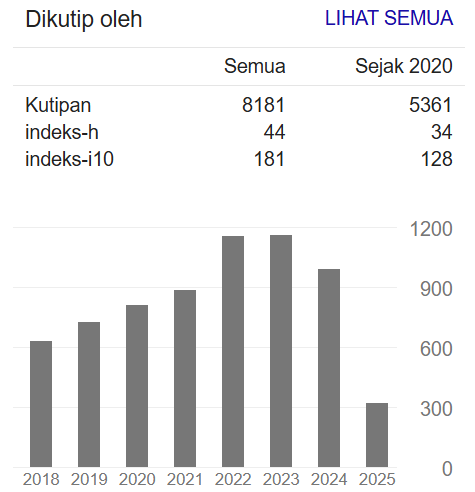TELEREHABILITATION TO IMPROVE PHYSICAL ACTIVITY IN HEARTH FAILURE PATIENTS
DOI:
https://doi.org/10.34011/jmp2k.v35i3.3300Keywords:
aktivitas fisik, gagal jantung, IPAQ, telerehabilitasiAbstract
Gagal jantung mengakibatkan penurunan fungsi tubuh yang dikaitkan dengan gangguan kemampuan jantung dalam memompa darah. Kondisi ini mengakibatkan pasien mudah merasa lelah dan sesak napas, sehingga mengurangi kemampuan dalam melakukan aktivitas fisik. Telerehabilitasi manjadi alternatif intervensi yang memanfaatkan teknologi komunikasi jarak jauh untuk memonitor pasien secara berkala. Penelitian ini bertujuan untuk mengidentifikasi efektivitas telerehabilitasi dalam meningkatkan kemampuan aktivitas fisik pada pasien gagal jantung. Studi eksperimental dilakukan pada 118 pasien gagal jantung yang dibagi menjadi kelompok intervensi dan kelompok kontrol. Intervensi yang diberikan berupa edukasi terstruktur mengenai rehabilitasi fase 4 dan monitoring dilakukan jarak jauh selama 4 minggu dilakukan menggunakan telepon seluler. Instrumen International Physical Activity Questionnaire (IPAQ) digunakan untuk menilai tingkat kemampuan aktivitas fisik. Hasil analisis uji paired sample t-test menunjukkan adanya peningkatan yang signifikan secara statistik pada rata-rata skor aktivitas fisik sebesar 0,66 pasca intervensi telerehabilitasi (p<0,001). Telerehabilitasi terbukti efektif dalam meningkatkan kemampuan aktivitas fisik pasien gagal jantung. Intervensi ini dapat dijadikan alternatif tindakan mandiri perawat yang efektif dan efisien.
References
P. Kennelly, R. Sapkota, M. Azhar, F. H. Cheema, C. Conway, and A. Hameed, “Diuretic Therapy in Congestive Heart Failure,” Acta Cardiol., vol. 77, no. 2, pp. 97–104, 2022, doi: 10.1080/00015385.2021.1878423.
WHF, “World Heart Report 2023 Confronting The World’s Number One Killer,” World Hear. Rep., 2023, [Online]. Available: https://world-heart-federation.org/wp-content/uploads/World-Heart-Report-2023.pdf
S. S.Martin et al., “2024 Heart Disease and Stroke Statistics : A Report of US and Global Data From the American Heart Association,” 2024. doi: 10.1161/CIR.0000000000001209.
Badan Penelitian dan Pengembangan Kesehatan Kemenkes, “Laporan Nasional Riskesdas 2023,” 2023. [Online]. Available: https://www.badankebijakan.kemkes.go.id/laporan-tematik-ski/
G. Cattadori, C. Segurini, A. Picozzi, L. Padeletti, and C. Anzà, “Exercise and Heart Failure : an update,” ESC Hear. Fail., vol. 5, pp. 222–232, 2018, doi: 10.1002/ehf2.12225.
B. Bozkurt et al., “Universal Definition and Classification of Heart Failure A Report of the Heart Failure Society of America , Heart Failure Association of the European Society of Cardiology , Japanese Heart Failure Society and Writing Committee of the Universal Definition,” J. Card. Fail., vol. 27, no. 4, pp. 387–409, 2021, doi: 10.1016/j.cardfail.2021.01.022.
Nurkhalis and R. J. Adista, “Manifestasi Klinis dan Tatalaksana Gagal Jantung,” J. Kedokt. Nanggroe Med., vol. 3, no. 3, pp. 36–46, 2020, doi: https://doi.org/10.35324/jknamed.v3i3.106.
D. H. Sisilia Hani Oktavira, “Hubungan Aktivitas Fisik Dengan Kualitas Tidur Pada Pasien Gagal Jantung,” http//journal.stikeskendal.ac.id/index.php/Keperawatan Hub., vol. 15, pp. 279–288, 2023, doi: https://doi.org/10.32583/keperawatan.v15i4.1989.
R. Glowczynska, M. Banach, D. Szalewska, and R. Piotrowicz, “Prognostic Impact of Hybrid Comprehensive Telerehabilitation Regarding Diastolic Dysfunction in Patients with Heart Failure with Reduced Ejection Fraction — Subanalysis of the Telereh-HF Randomized Clinical Trial,” J. Clin. Med., vol. 11, p. 1844, 2022, doi: https://doi.org/10.3390/jcm11071844.
A. P. Lumi, V. F. F. Joseph, and N. C. I. Polii, “Rehabilitasi Jantung pada Pasien Gagal Jantung Kronik,” vol. 13, no. 28, pp. 309–316, 2021, doi: https://doi.org/10.35790/jbm.v13i3.33448.
C. H. Davos et al., “Secondary Prevention Through Comprehensive Cardiovascular Rehabilitation : From Knowledge to Implementation. 2020 update. A position paper from the Secondary Prevention and Rehabilitation Section of the European Association of Preventive Cardiology,” Eur. J. Prev. Cardiol., vol. 28, no. 5, pp. 1–42, 2020, doi: 10.1177/2047487320913379.
R. S. Taylor, H. M.Dalal, and S. T. . McDonagh, “The Role of Cardiac Rehabilitation in Improving Cardiovascular Outcomes,” Nat. Rev. Cardiol., vol. 19, pp. 180–194, 2022, doi: 10.1038/s41569-021-00611-7.
M. Simon, K. Korn, L. Cho, B. Gordon G, and C. Raymond, “Cardiac Rehabilitation : A class 1 recommendation,” Cleve. Clin. J. Med., vol. 85, no. 7, pp. 551–558, 2018, doi: 10.3949/ccjm.85a.17037.
A. Noites et al., “Effects of a Phase IV Home-Based Cardiac Rehabilitation Program on Cardiorespiratory Fitness and Physical Activity,” Hear. Lung Circ., vol. 26, no. 5, pp. 455–462, 2017, doi: 10.1016/j.hlc.2016.08.004.
G. O. Dibben, H. M. Dalal, R. S. Taylor, P. Doherty, L. H. Tang, and M. Hillsdon, “Cardiac Rehabilitation and Physical Activity : Systematic Review and Meta-Analysis,” BMJ J., vol. 104, no. 17, pp. 1394–1402, 2018, doi: 10.1136/heartjnl-2017-312832.
B. Dinesen et al., “‘ Future patient II ’ Telerehabilitation for Patients with Heart Failure : Protocol for a Randomized Controlled Trial,” Int. J. Cardiol. Cardiovasc. Risk Prev. J., vol. 20, no. December 2023, 2024, doi: 10.1016/j.ijcrp.2024.200239.
A. H. Cavalheiro, J. S. Cardoso, A. Rocha, E. Moreira, and L. F. Azevedo, “Effectiveness of Tele-rehabilitation Programs in Heart Failure : A Systematic Review and Meta-analysis,” Heal. Serv. Insights, vol. 14, pp. 1–10, 2021, doi: 10.1177/11786329211021668.
E. Piotrowicz et al., “Heart Failure Patients’ Adherence to Hybrid Comprehensive Telerehabilitation and Its Impact on Prognosis Based on Data from Telereh-HF Randomized Clinical Trial,” Appl. Sci., vol. 12, no. 4, p. 5, 2022, doi: https://doi.org/10.3390/app12052595.
C. S. Schacksen, N. C. Henneberg, and J. A. Muthulingam, “Effects of Telerehabilitation Interventions on Heart Failure Management ( 2015-2020 ): Scoping Review Corresponding Author :,” JMIR Rehabil. Assist. Technol., vol. 8, pp. 1–11, 2021, doi: 10.2196/29714.
R. Hwang, E. M. Gane, and N. R. Morris, “No transport ? No worries ! Cardiac telerehabilitation is a feasible and effective alternative to centre ‑ based programs,” Heart Fail. Rev., vol. 28, no. 6, pp. 1277–1284, 2023, doi: 10.1007/s10741-023-10301-w.
Brouwers et al., “Cardiac Telerehabilitation as an Alternative to Centre-Based Cardiac Rehabilitation,” Neth Hear. J, vol. 28, pp. 443–451, 2020, doi: 10.1007/s12471-020-01432-y.
C. S. Schacksen, A. Dyrvig, N. C. Henneberg, and J. Dam, “Patient-Reported Outcomes From Patients With Heart Failure Participating in the Future Patient Telerehabilitation Program : Data From the Intervention Arm of a Randomized Controlled Trial Corresponding Author :,” JMIR Cardio, vol. 5, pp. 1–12, 2021, doi: 10.2196/26544.
S. I. S. Calvini, “Home-Based Telerehabilitation in Older Patients With Chronic Obstructive Pulmonary Disease and Heart Failure : a Randomised Controlled Trial,” Oxford Univ. Press behalf Br. Geriatr. Soc., vol. 47, pp. 82–88, 2018, doi: 10.1093/ageing/afx146.
M. Chimura et al., “Evaluation of the Efficacy and Safety of an Integrated Telerehabilitation Platform for Home-Based Cardiac Rehabilitation in Patients with Heart Failure ( E- REHAB ): Protocol for a Randomised Controlled Trial,” BMJ Open, vol. 13, no. 8, pp. 1–10, 2023, doi: 10.1136/bmjopen-2023-073846.
E. Piotrowicz et al., “Predictors of Long-Term Prognosis Based on Clinical Status and Measurements Obtained in Heart Failure Patients After 9-Week Hybrid Comprehensive Telerehabilitation : A Subanalysis of the TELEREH-HF Randomized Clinical Trial,” Polish Hear. J., vol. 81, no. 7–8, pp. 726–736, 2023, doi: 10.33963/KP.a2023.0116.
E. Piotrowicz, R. Piotrowicz, G. Opolski, and M. Pencina, “Hybrid Comprehensive Telerehabilitation in Heart Failure Patients ( Telereh-HF ): A Randomized , Multicenter , Prospective , Open- Label , Parallel Group Controlled Trial — Study Design and Description of the Intervention,” Am. Heart J., vol. 217, pp. 148–158, 2019, doi: 10.1016/j.ahj.2019.08.015.
D. Dharmansyah and D. Budiana, “Indonesian Adaptation of The International Physical Activity Questionnaire ( IPAQ ): Psychometric Properties,” J. Pendidik. Keperawatan Indones., vol. 7, no. 2, pp. 159–163, 2021, doi: 10.17509/jpki.v7i2.39351.
S. Ayu, K. Candrawati, N. K. Sukraandini, and K. P. Sarjana, “Kecemasan Lansia dengan Kondisi Penyakit Kronis,” J. Akad. Baiturrahim Jambi, vol. 11, no. 2, pp. 348–355, 2022, doi: https://doi.org/10.36565/jab.v11i2.631.
A. A. K. Y. Paramita, M. R. Saraswati, and N. Wiryawan, “Gambaran Karakteristik Gagal Jantung pada Pasien Diabetes Melitus di RSUP Sanglah Denpasar,” J. Penyakit Dalam Udayana, vol. 5, no. 2, pp. 37–45, 2021, doi: https://doi.org/10.36216/jpd.v5i2.152.
N. P. Rudolof A. Donsu, Starry H. Rampengan, “Karakteristik Pasien Gagal Jantung Akut di RSUP Prof Dr . R . D . Kandou Periode Januari - Desember 2018,” Med. Scope J. (MSJ)., vol. 1, no. 2, pp. 30–37, 2020, doi: https://doi.org/10.35790/msj.v1i2.27463.
M. Tomaszewski, W. Topyła, B. G. Kijewski, P. Miotła, and P. Waciński, “Review paper Does gender influence the outcome of ischemic heart disease ?,” Menopause riview, vol. 18, no. 1, pp. 51–56, 2019, doi: https://doi.org/10.5114/pm.2019.84158.
D. A. Purnamawati, F. Arofiati, and A. Relawati, “Pengaruh Supportive-Educative System terhadap Kualitas Hidup pada Pasien Gagal Jantung The Effect of Supportive-Educative System on Quality of Life in Patients with Heart Failure,” Mutiara Med. J. Kedokt. dan Kesehat., vol. 18, no. 2, pp. 41–44, 2018, doi: 10.18196/mm.180213.
B. Kristinawati and R. N. Khasanah, “Hubungan Pelaksanaan Edukasi dengan Kemampuan Self Care Management Pasien Gagal Jantung,” Pros. Univ. Res. Colloq., pp. 496–503, 2019, [Online]. Available: https://repository.urecol.org/index.php/proceeding/article/view/682
A. Groenewegen, F. H. Rutten, A. Mosterd, and A. W. Hoes, “Epidemiology of Heart Failure Measuring an Epidemic,” Eur. Soc. Cardiol., vol. 22, no. 8, pp. 1342–1356, 2020, doi: 10.1002/ejhf.1858.
K. Ainunnisa and D. Hudiyawati, “Hubungan Antara Jenis Kelamin Dengan Tingkat Kecemasan Pada Pasien Gagal Jantung,” Dr. Diss. Univ. Muhammadyah Surakarta, 2020, [Online]. Available: https://eprints.ums.ac.id/id/eprint/83024
Eva, H. Lim, and E. Julianto, “Literature Riview Hubungan Merokok dan Hipertensi Pada Pasien Penyakit Jantung Koroner,” J. Kedokt. Methodist, vol. 15, no. 1, pp. 95–106, 2021, [Online]. Available: https://ejurnal.methodist.ac.id/index.php/jkm/article/view/1598
J. Slivnick and B. C. Lampert, “Hypertension and Heart Failure,” Heart Fail. Clin., vol. 15, no. 4, pp. 531–541, 2019, doi: 10.1016/j.hfc.2019.06.007.
G. C. Oh and H. Cho, “Blood Pressure and Heart Failure,” Clin. Hypertens., vol. 26, no. 1, pp. 1–8, 2020, doi: https://doi.org/10.1186/s40885-019-0132-x.
F. Triposkiadis et al., “Diabetes Mellitus and Heart Failure,” J. Clin. Med., vol. 10, no. 16, pp. 1–21, 2021, doi: doi.org/10.3390/jcm10163682.
W. C. Meijers and R. A. De Boer, “Common Risk Factors for Heart Failure and Cancer,” Eouropean Soc. Cardiol., vol. 115, pp. 844–853, 2019, doi: 10.1093/cvr/cvz035.
A. Istiqomah1, Chrisyen Damanik2, “Aktivitas Fisik Pada Pasien Gagal Jantung Selama Masa Pandemi COVID-19,” J. Keperawatan Wiyata, vol. 2, pp. 31–40, 2021, [Online]. Available: https://garuda.kemdikbud.go.id/documents/detail/2733818
N. F. Arifudin et al., “Dampak Masalah Psikologis Terhadap Kualitas Hidup Pasien Gagal Jantung: Systematic Review,” HIJP Heal. Inf. J. Penelit., vol. 15, 2023, [Online]. Available: https://myjurnal.poltekkes-kdi.ac.id/index.php/hijp/article/view/796
F. K. Ho et al., “Association Between Device-Measured Physical Activity and Incident Heart Failure : A Prospective Cohort Study of 94 739 UK Biobank Participants,” Am. Hear. Asoc., vol. 146, no. 12, pp. 883–891, 2022, doi: 10.1161/CIRCULATIONAHA.122.059663.
S. Sankaran, K. Luyten, D. Hansen, P. Dendale, J. Hospital, and K. Coninx, “Enhancing Patient Motivation to Achieve Physical Activity Targets in Cardiac Tele-rehabilitation,” BCS Learn. Dev., pp. 1–12, 2018, doi: http://dx.doi.org/10.14236/ewic/HCI2018.48 Have.
M. Sunamura, H. J. Stam, E. Boersma, M. L. Geleijnse, R. T. Van Domburg, and R. J. G. Van Den Berg-emons, “Effects of Two Behavioral Cardiac Rehabilitation Interventions on Physical Activity : A Randomized Controlled Trial,” Int. J. Cardiol., vol. 255, pp. 221–228, 2018, doi: 10.1016/j.ijcard.2017.12.015.
N. M. B.Kristinawati, N.Wijayanti, “Improving Medication Adherence of Patients with Heart Failure Using Tele-Motivational Interviewing,” Eur. Rev. Med. Pharmacol. Sci., vol. 27, pp. 10171–10180, 2023, [Online]. Available: https://www.europeanreview.org/wp/wp-content/uploads/10171-10180.pdf
A. E. Lacraru et al., “Assessing the Efficacy of a Virtual Assistant in the Remote Cardiac Rehabilitation of Heart Failure and Ischemic Heart Disease Patients : Case-Control Study of Romanian Adult Patients,” Int. J. Environ. Res. Publik Heal., vol. 20, no. 5, 2023, doi: https://doi.org/10.3390/ ijerph20053937.
K. M. Lundgren et al., “Feasibility of Telerehabilitation for Heart Failure Patients Inaccessible for Outpatient Rehabilitation,” ESC Hear. Fail., vol. 10, pp. 2406–2417, 2023, doi: 10.1002/ehf2.14405.
M. Scherrenberg, M. Falter, and P. Dendale, “Cost-Effectiveness of Cardiac Telerehabilitation in Coronary Artery Disease and Heart Failure Patients : Systematic Review of Randomized Controlled Trials,” Eouropan Soc. Cardiol., vol. 1, pp. 20–29, 2020, doi: 10.1093/ehjdh/ztaa005.
Downloads
Published
How to Cite
Issue
Section
Citation Check
License
Copyright (c) 2025 Shafira Eka Damayanti, Beti Kristinawati

This work is licensed under a Creative Commons Attribution-ShareAlike 4.0 International License.




